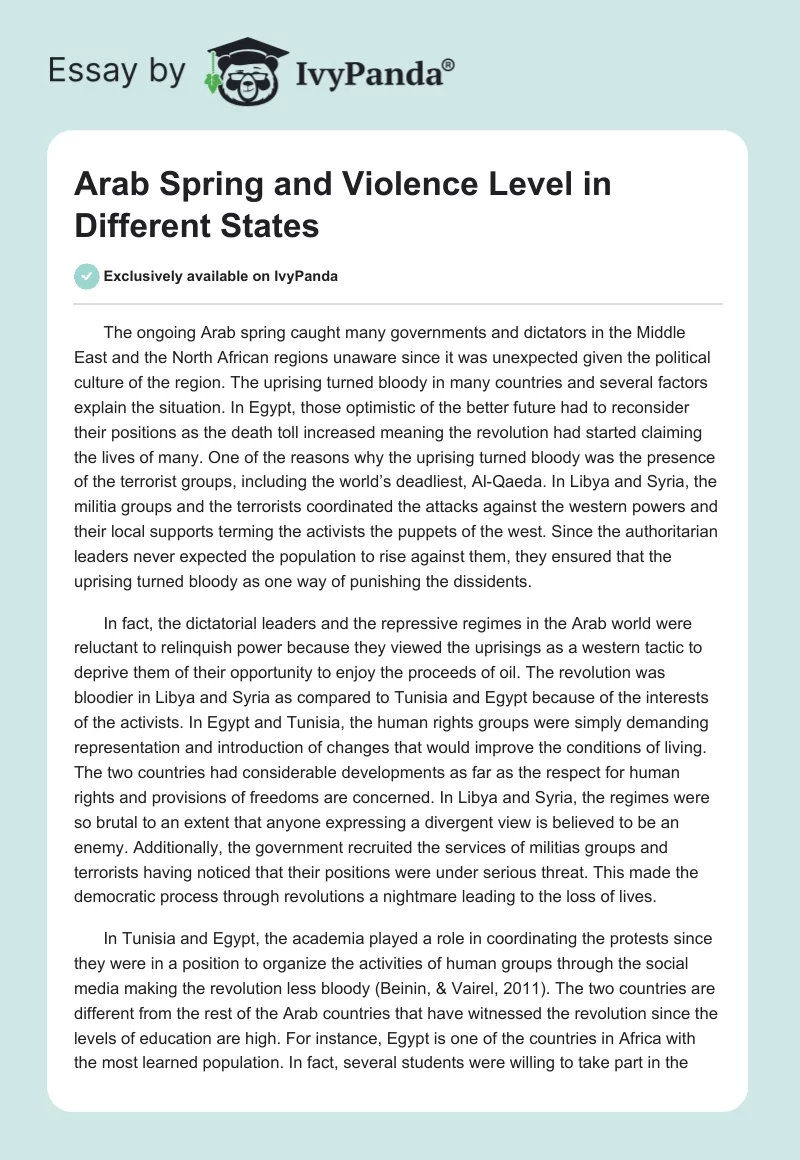The ongoing Arab spring caught many governments and dictators in the Middle East and the North African regions unaware since it was unexpected given the political culture of the region. The uprising turned bloody in many countries and several factors explain the situation. In Egypt, those optimistic of the better future had to reconsider their positions as the death toll increased meaning the revolution had started claiming the lives of many. One of the reasons why the uprising turned bloody was the presence of the terrorist groups, including the world’s deadliest, Al-Qaeda. In Libya and Syria, the militia groups and the terrorists coordinated the attacks against the western powers and their local supports terming the activists the puppets of the west. Since the authoritarian leaders never expected the population to rise against them, they ensured that the uprising turned bloody as one way of punishing the dissidents.
In fact, the dictatorial leaders and the repressive regimes in the Arab world were reluctant to relinquish power because they viewed the uprisings as a western tactic to deprive them of their opportunity to enjoy the proceeds of oil. The revolution was bloodier in Libya and Syria as compared to Tunisia and Egypt because of the interests of the activists. In Egypt and Tunisia, the human rights groups were simply demanding representation and introduction of changes that would improve the conditions of living. The two countries had considerable developments as far as the respect for human rights and provisions of freedoms are concerned. In Libya and Syria, the regimes were so brutal to an extent that anyone expressing a divergent view is believed to be an enemy. Additionally, the government recruited the services of militias groups and terrorists having noticed that their positions were under serious threat. This made the democratic process through revolutions a nightmare leading to the loss of lives.
In Tunisia and Egypt, the academia played a role in coordinating the protests since they were in a position to organize the activities of human groups through the social media making the revolution less bloody (Beinin, & Vairel, 2011). The two countries are different from the rest of the Arab countries that have witnessed the revolution since the levels of education are high. For instance, Egypt is one of the countries in Africa with the most learned population. In fact, several students were willing to take part in the demonstrations having accused the government of relative deprivation for several years. The issues raised in Egypt were different from the demands of activists in Syria and Libya. In Tunisia, the despotic leaders were open to negotiations since they were not in touch with the majority having ruled the country for several years without initiating changes.
In the case of Libya and Syria, the foreign powers were accused of destabilizing the government with the sole purpose of acquiring oil cheaply. The Libyan leader, Muammar Gaddafi, was the people’s darling and many individuals, as well as his soldiers, were willing to sacrifice their lives to ensure he remained in power. The case was different in Egypt since the leader had lost the support of the elites because of introducing unfavourable economic and social policies. In Syria, the supremacy war between the US and Russia is affecting the peace process because both sides are unwilling to drop their demands. Putin and the Chinese government are supporting Assad, as they provide financial and military support. The war played out in the Security Council when the representatives failed to slap economic and political sanctions to Assad’s government.
References
Beinin, J., & Vairel, F. (2011). Social Movements, Mobilization, and Contestation in the Middle East and North Africa. Stanford: Stanford University press.


